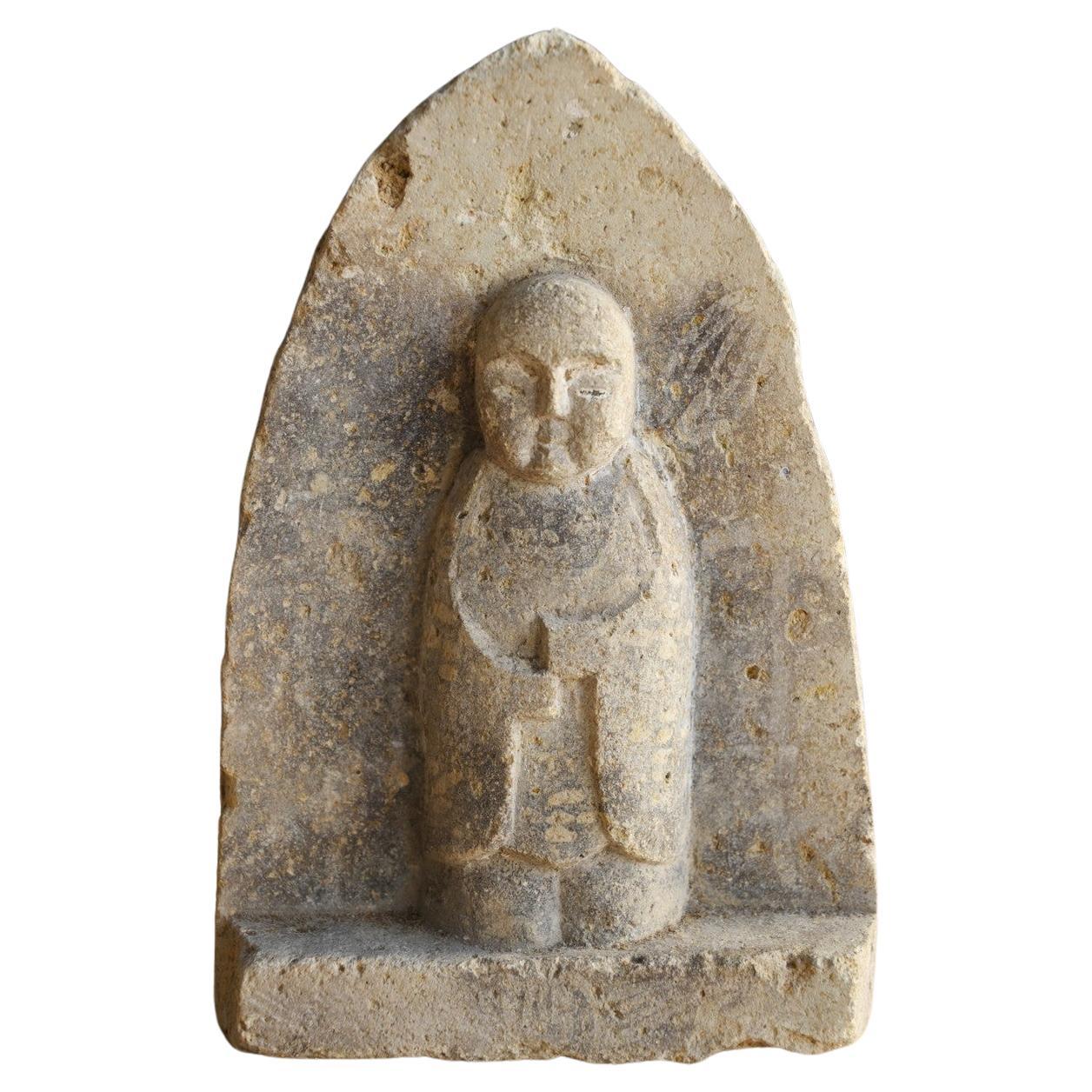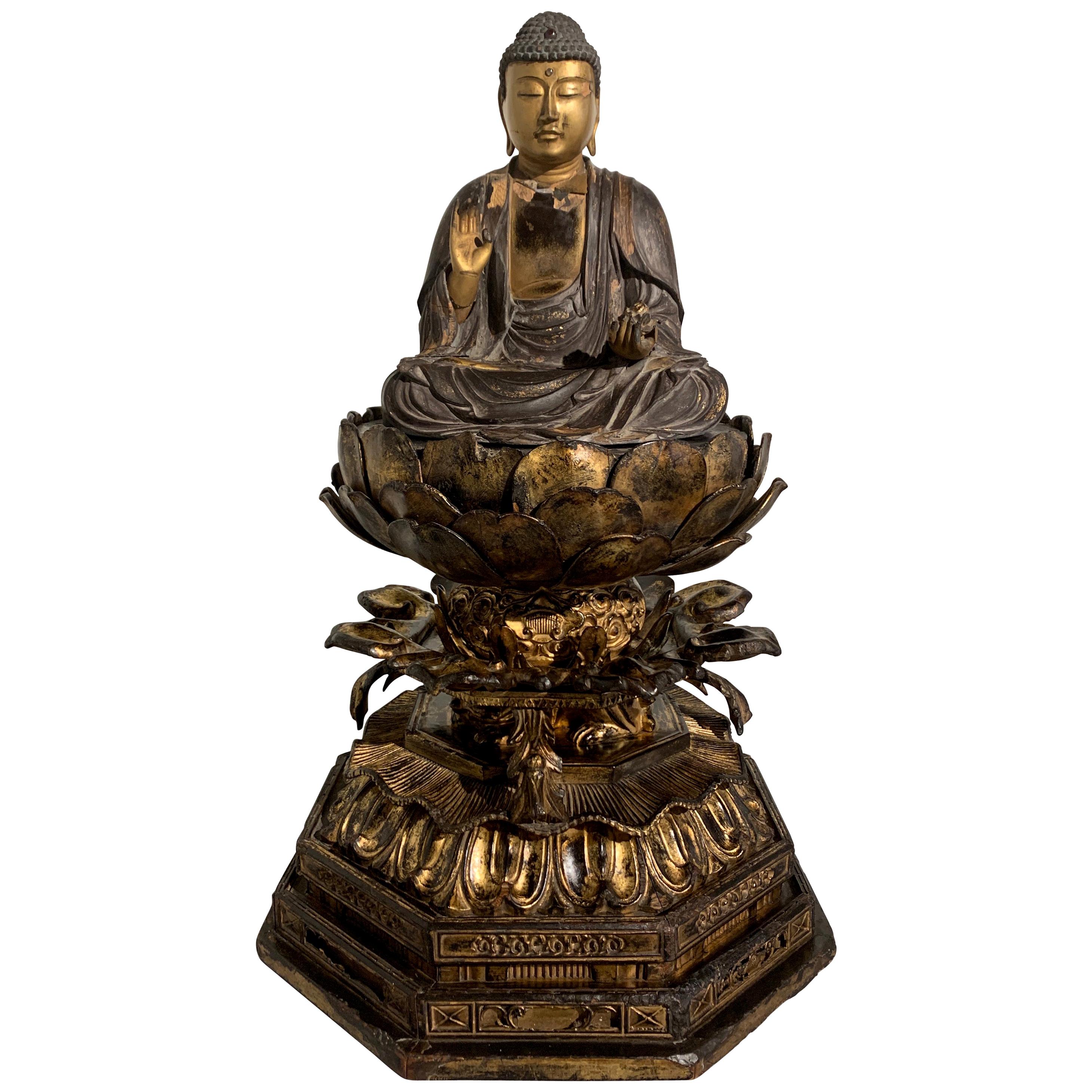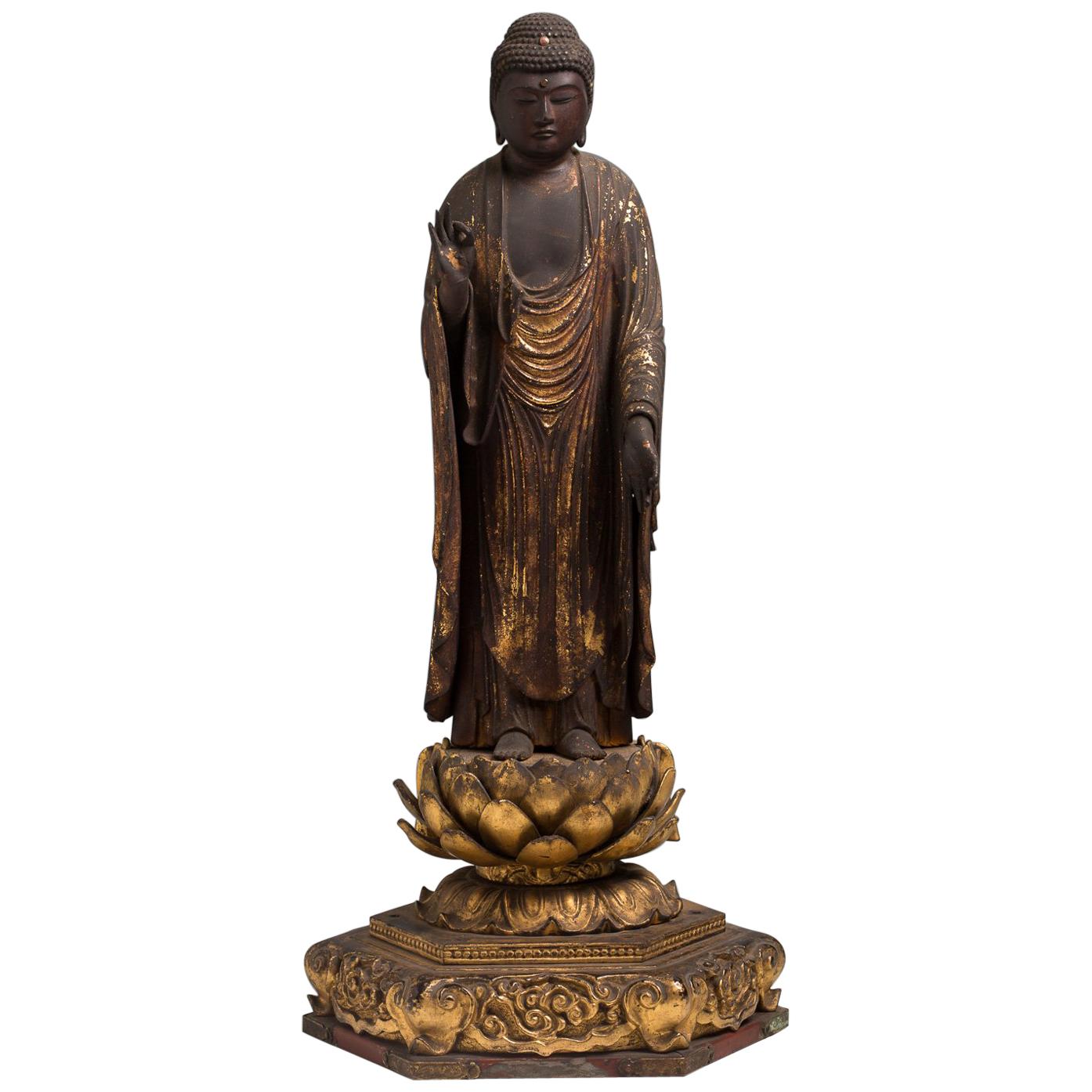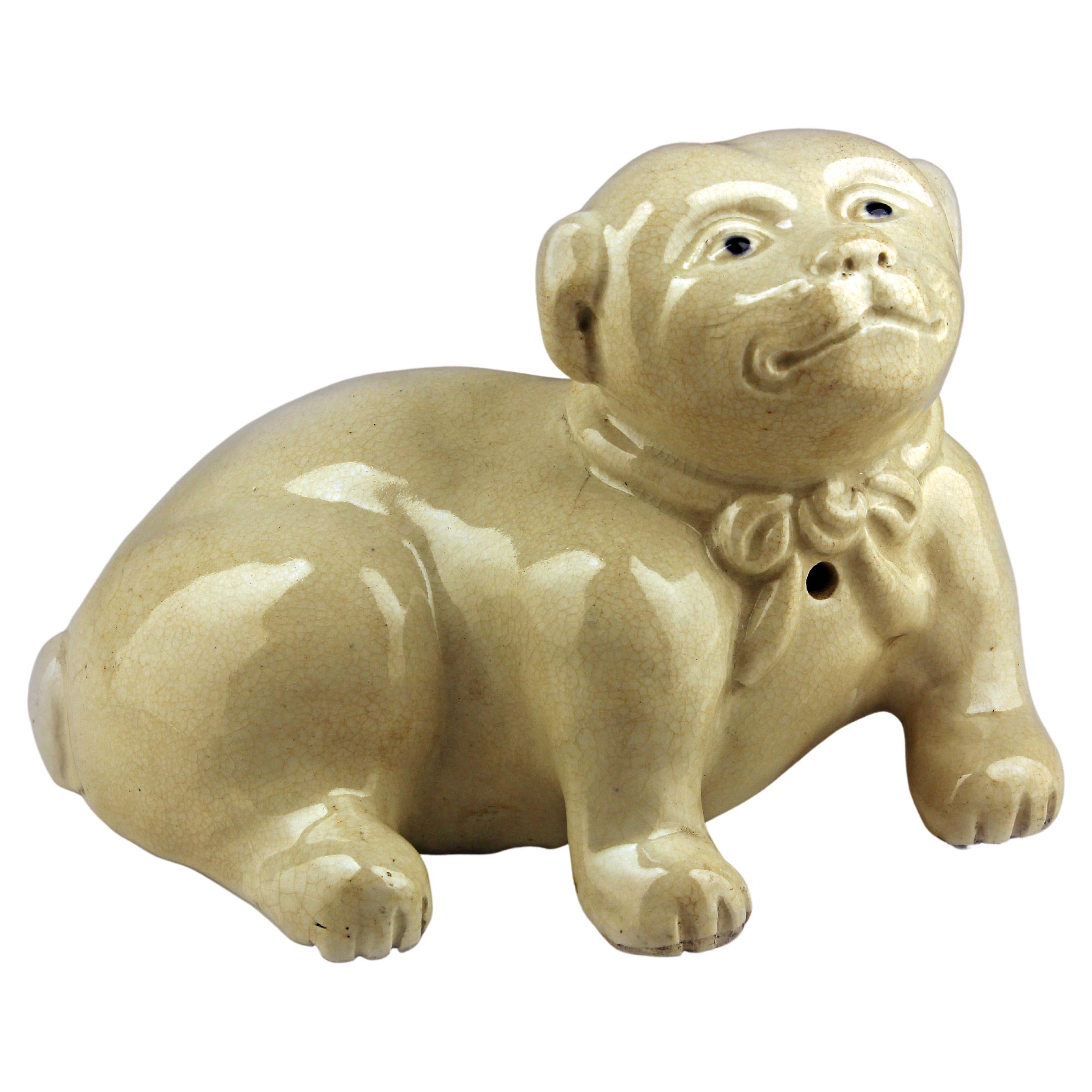Items Similar to Japanese Standing Gilt Buddha, Amida Nyorai, Edo Period, 18th century, Japan
Want more images or videos?
Request additional images or videos from the seller
1 of 18
Japanese Standing Gilt Buddha, Amida Nyorai, Edo Period, 18th century, Japan
About the Item
An exquisite Japanese carved hinoki and gilt lacquered standing figure of Amida Nyorai, Amitabha Buddha, Edo Period, 18th century, Japan.
The spectacular fully gold gilt figure of Amida Nyorai is portrayed standing upon an elaborate lotus pedestal with individually carved petals painted in green and blue mineral pigments with gilt highlights. The open lotus is supported by a charming blue painted shishi on an ornate fluted and undulating base. This figure of Amida Nyorai is luminous, covered all over in a rich and bright gold lacquer.
Amida Nyorai, Amitabha Buddha, the Buddha of Infinite Light, is dressed in loose fitting robes that drape elegantly around his robust figure, leaving his chest and the top of his belly exposed.
He holds his hands in raigo-in, the mudra of welcoming, performed with the thumb touching the index finger. This gesture is used to remind worshipers of Amida Buddha's promise to welcome them into his Western Paradise, or Pure Land when they pass from this realm. It is believed Amida himself descends from the Pure Land to guide the faithful to his paradise.
His full, round face is calm and expressive. He looks out from heavily lidded and downcast inset and painted rock crystal eyes. High arched brows, a broad, flat nose and plump lips set in a complete the face. The forehead with a hole that once held a now-missing urna. Narrow, s-shaped ears with long earlobes and blue painted hair arranged in the traditional neat rows of curls over a pronounced ushnisha frame the face.
This figure of Amida Nyorai is carved from hinoki (cypress) wood, gessoed, lacquered, and gilt. The gilding worn in some areas, revealing the black lacquer below.
Provenance: The estate of T. Boone Pickens, Dallas, TX
- Dimensions:Height: 20.5 in (52.07 cm)Width: 8.5 in (21.59 cm)Depth: 7.5 in (19.05 cm)
- Style:Edo (Of the Period)
- Materials and Techniques:
- Place of Origin:
- Period:
- Date of Manufacture:18th century
- Condition:Repaired: Both hands and one foot with evidence of glue repair. Wear consistent with age and use. Minor losses. Minor structural damages. Minor fading. Losses to the fingertips and tips of the lotus petals. Missing the crystal urna in the forehead. The mandorla missing. Slight flaking and loss to the lacquer, as seen in photos.
- Seller Location:Austin, TX
- Reference Number:1stDibs: LU894734734212
About the Seller
5.0
Gold Seller
These expertly vetted sellers are highly rated and consistently exceed customer expectations.
Established in 2001
1stDibs seller since 2010
305 sales on 1stDibs
Typical response time: 1 hour
- ShippingRetrieving quote...Ships From: Austin, TX
- Return PolicyA return for this item may be initiated within 7 days of delivery.
More From This SellerView All
- Japanese Giltwood Medicine Buddha, Yakushi Nyorai, Muromachi Period 16th CenturyLocated in Austin, TXA striking Japanese late Muromachi Period (1333-1573) lacquered and giltwood figure of Yakushi Nyorai, the Medicine Buddha, seated upon an elaborate car...Category
Antique 16th Century Japanese Edo Sculptures and Carvings
MaterialsRock Crystal
- Japanese Carved and Lacquered Wood Shogun, Edo Period, 19th Century, JapanLocated in Austin, TXAn unusual Japanese carved wood, lacquer, and gilt decorated portrait sculpture of a shogun, Edo Period, early 19th century, Japan. The unidentified shogun (possibly Tokugawa Iey...Category
Antique Mid-19th Century Japanese Edo Sculptures and Carvings
MaterialsWood, Lacquer
- Shan Burmese Lacquered and Gilt Wood Buddha, Ava Period, 18th CenturyLocated in Austin, TXA rare and exquisite 18th century Ava period Shan Burmese figure of the Buddha. Carved from a single block of wood, lacquered and gilt, the immensely s...Category
Antique Mid-18th Century Burmese Sculptures and Carvings
MaterialsTeak
- Japanese Parcel Gilt Copper Hibachi, Edo Period, 18th Century, JapanLocated in Austin, TXA sublime Japanese parcel gilt copper hand warmer, hibachi, with chrysanthemum design, Edo Period, 18th century, Japan. The hand warmer, called a...Category
Antique 18th Century Japanese Edo Metalwork
MaterialsCopper
- Pair of Japanese Edo Period Musha Ningyo Courtier DollsLocated in Austin, TXTwo exquisite Japanese musha ningyo dolls, crafted as courtiers, Edo Period, early 19th century, Japan. The older man can be identified as the h...Category
Antique Early 19th Century Japanese Edo Sculptures and Carvings
MaterialsShell, Brocade, Silk, Glass, Wood, Paint, Paper
- Burmese Arakan Lacquered and Gilt Bronze Healing Buddha, 18th CenturyLocated in Austin, TXAn unusual 18th century Burmese Arakan style red lacquered and richly gilt cast bronze figure of the Crowned Medicine Buddha, commonly referred to as Bhaishajyaguru. The Supreme Healer is portrayed seated in vajrasana (full lotus position) upon a throne of nine elephants, symbolizing the practice of samatha, or calming the mind (mindfulness) - specifically the nine stages of calm abiding. The hand in his lap holds a jar of healing salve. His other hand rests gently on his knee in varada mudra, the gesture of wish fulfilling, offering a myrobalan seed, a fruit said to be capable of healing emotional ills. The Healing Buddha...Category
Antique Mid-18th Century Burmese Sculptures and Carvings
MaterialsBronze
You May Also Like
- Carved Wood Gilt-Lacquered Sculpture of Seated Japanese Edo Buddha Amida NyoraiLocated in Studio City, CAA truly beautiful and supremely serene Japanese Amida Nyorai Buddha. A magnificent work. Meticulously hand carved in such fine and amazing detail (see hands and flowing robes). Gilded throughout. Seated with narrowed eyes in deep meditation and hands in Buddhist Abhaya Mudra position offering a blessing of protection, reassurance, peace, and benevolence. This hand position, also known as the "fear not" gesture, was achieved by Buddha immediately following his enlightenment. This work is from the late Edo period, (1603-1868)/ early Meiji period (1868-1912). From a California collection. Would be a fantastic addition to any Japanese or Asian artifacts/buddha collection or eye-catching stand-alone accent work in about any setting. One of the best Japanese Buddha sculptures...Category
Antique 19th Century Japanese Edo Sculptures and Carvings
MaterialsWood, Giltwood, Lacquer
- Carved Wood Gilt-Lacquered Sculpture of Seated Japanese Edo Buddha Amida NyoraiLocated in Studio City, CAThis truly a magnificent piece. Stunning. Beautiful. Supremely serene. Meticulously hand carved in such fine and amazing detail (see hands and flowing robes). Gilded throughout. S...Category
Antique Late 19th Century Japanese Edo Sculptures and Carvings
MaterialsLacquer, Wood
- Japanese antique small Jizo stone Buddha/18th-19th century/Edo periodLocated in Sammu-shi, ChibaThis is a small stone Buddha made during the Edo period in Japan. His dignity is "Jizo Bodhisattva". She has a cute figure and a gentle face. It also depicts a lotus flower, with bo...Category
Antique 18th Century Japanese Edo Sculptures and Carvings
MaterialsStone
- Japanese Wooden Buddhist Sculpture of Amida Nyorai, 16th CenturyLocated in Milano, ITThe Amitabha (Amida in Japanese) Buddha is shown standing with his hands forming the Amida raigo-in mudra. The face has a serene expression, with closed eyes under delicately arched brows and a severe face. The hair is arranged in rows of coils that also cover the "ushnisha", the protuberance on the head. The drapery is folded in elegant pleats falling from the shoulders to the feet. The antique sculpture is placed on a lotus flower which is located on a richly decorated base. Faith in Amida Buddha remained largely confined to a small segment of the Japanese population until the Kamakura Era (1185-1333) when it was popularized by new Pure Land sects committed to bringing Buddhism to the illiterate commoner. These sects expressed concern for the salvation of the ordinary person and stressed pure and simple faith over complicated rites and doctrines. Amida Nyorai...Category
Antique 16th Century Japanese Sculptures and Carvings
MaterialsWood
- Late 18th Century/Edo-Meiji Period Japanese Glazed Porcelain Sculpture of a DogLocated in North Miami, FLLate 18th century/Edo-Meiji period japanese glazed porcelain sculpture of a dog By: unknown Material: porcelain Technique: molded, pressed, glazed Dimensions: 5.5 in x 7.5 in x 5 Da...Category
Antique Late 18th Century Japanese Edo Sculptures and Carvings
MaterialsPorcelain
- Japanese antique wooden Buddha statue/Folk Buddha/Edo period/1603-1868Located in Sammu-shi, ChibaThis is an old Japanese Buddhist statue made around the Edo period. The material is believed to be cypress or cedar. The square pedestal at t...Category
Antique 17th Century Japanese Edo Sculptures and Carvings
MaterialsCypress
Recently Viewed
View AllMore Ways To Browse
Burmese Praying Monk
Barong Sculpture
Dinner Chimes Antique
Chiang Saen
Chinese Carved Coral Figural Group
Ming Bronze Guanyin
Baby Bronze Buddha
Bronze Cambodia Statue
Quan Yin With Lotus Flower
Vintage Chinese Cork Carving
White Tiger Statue
Antique Chinese Libation Cup
Chinese Royalty Statue
Jade Scepter
Japanese Moon Gazing Rabbit
Tall Cast Iron Candle Sticks
Antique Hetian Jade
Burmese Praying Monk Wood Carving





